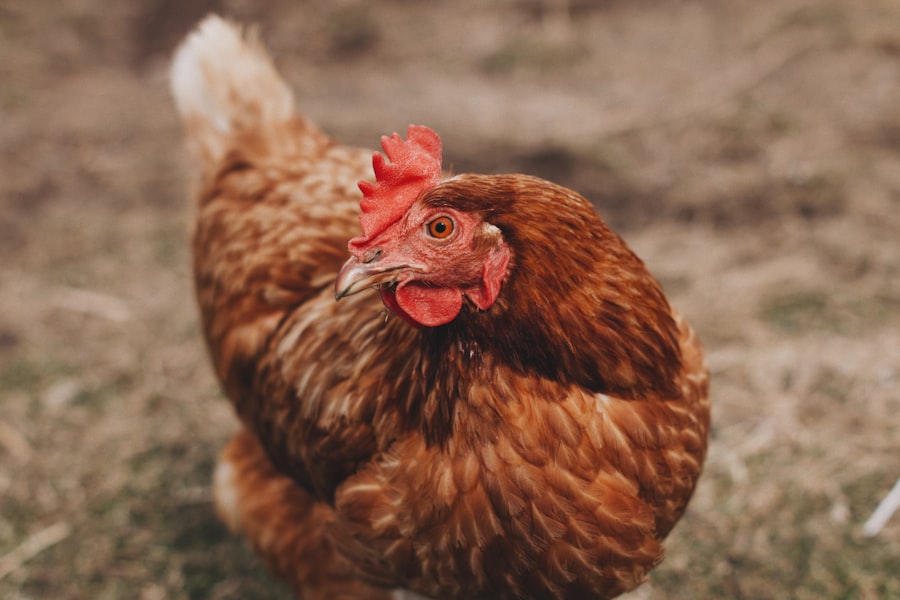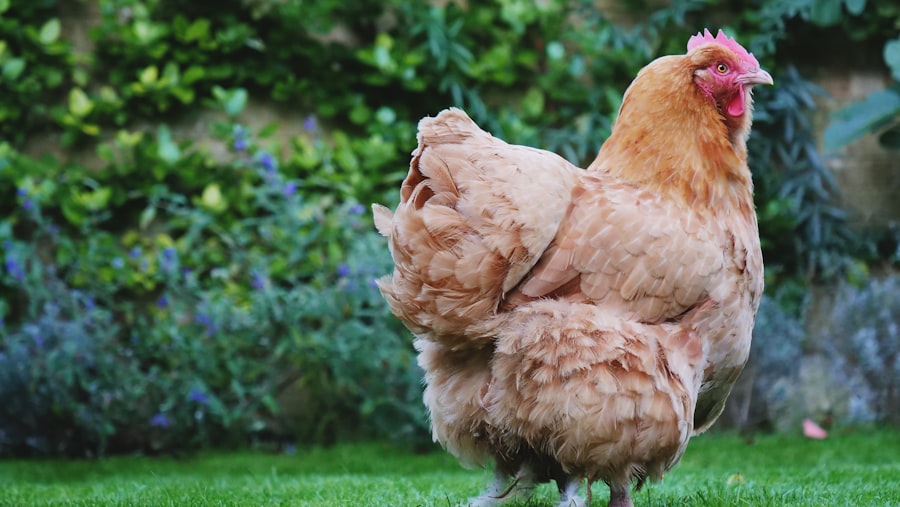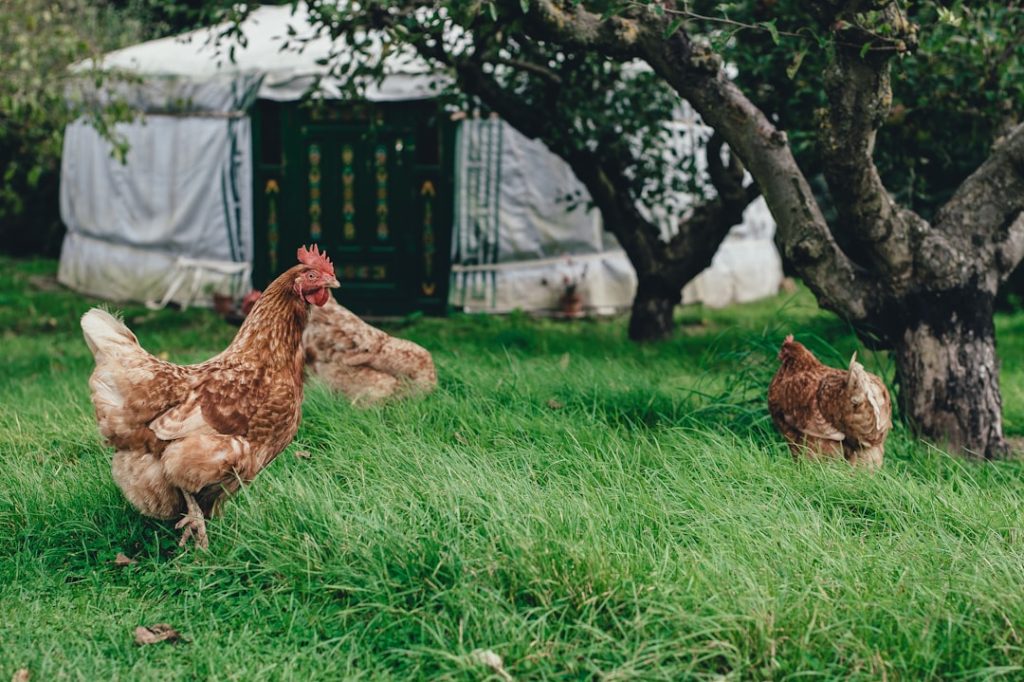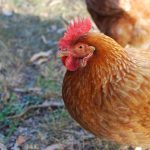Broodiness in chickens is a natural instinct that causes hens to incubate their eggs. This behavior is triggered by hormonal changes and the presence of a clutch of eggs. Broody hens spend most of their time sitting on the eggs, maintaining proper temperature and regularly turning them.
This process is crucial for embryo development and the continuation of the chicken species. Many chicken breeds exhibit broodiness, a behavior that has been observed for centuries. It is an integral part of chicken reproduction and plays a significant role in their life cycle.
While broodiness is a natural occurrence, it can present challenges for chicken keepers who are unprepared to manage broody hens. Understanding the signs of broodiness and implementing appropriate management strategies is essential for successful chicken husbandry.
Table of Contents
Key Takeaways
- Broodiness in chickens refers to the natural instinct to sit on and hatch eggs.
- Signs of broodiness in chickens include staying in the nesting box for extended periods, puffing up and growling when approached, and plucking feathers to line the nest.
- Broodiness can significantly decrease egg production in a flock, as broody hens will stop laying eggs during this time.
- To manage broody hens, consider using a broody coop or cage to separate them from the nesting boxes, or try to break the broodiness by gently discouraging the behavior.
- The benefits of broodiness for chicken owners include natural incubation of eggs, reduced need for artificial incubation, and the potential to expand the flock without purchasing new chicks.
Signs that a chicken is broody
Excessive Nesting and Aggressive Behavior
One of the most obvious signs of a broody hen is when she spends an excessive amount of time sitting in the nesting box. Broody hens will often refuse to leave the nest, even when it’s time to eat or drink. They may also become more aggressive or defensive when approached, as they are trying to protect their eggs.
Physical Changes
Another sign of broodiness is when a hen’s comb and wattles become pale and shrink in size. This is due to the hormonal changes that occur when a hen becomes broody. Additionally, broody hens may pluck feathers from their breast area to create a warm space for the eggs, which can result in a patchy appearance on their chest.
Vocalizations and Communication
Some hens may also make clucking or purring sounds while sitting on the eggs, as they are communicating with their unhatched chicks. These vocalizations can be another indicator of broodiness in chickens.
Importance of Recognizing Broody Behavior
It is important for chicken owners to be aware of these signs so they can properly manage broody hens and their nesting behavior.
The impact of broodiness on egg production

Broodiness can have a significant impact on egg production in a flock of chickens. When a hen becomes broody, she will stop laying eggs and focus all of her energy on sitting on the clutch of eggs. This can result in a decrease in egg production for the entire flock, as broody hens will not contribute to the daily egg count.
Additionally, the duration of broodiness can vary from a few weeks to over a month, depending on the individual hen and breed. During this time, the broody hen will not lay any eggs, which can further impact the overall egg production of the flock. For commercial egg producers, broodiness can be particularly challenging, as it can disrupt the regular egg-laying schedule and result in decreased profits.
However, for small-scale chicken owners, the impact of broodiness on egg production may be less significant, especially if they are raising chickens for reasons other than egg production.
How to manage broody hens
Managing broody hens requires patience and understanding of their natural behavior. One approach to managing broodiness is to discourage the behavior by removing the hen from the nesting box and placing her in a separate area away from the eggs. This can help break the cycle of broodiness and encourage the hen to resume normal activities such as eating, drinking, and socializing with the rest of the flock.
Another method to manage broodiness is to provide distractions for the broody hen, such as placing fake eggs or golf balls in the nesting box. This can help satisfy the hen’s instinct to sit on something and may discourage her from sitting on her own eggs. Some chicken owners may also choose to use a wire or mesh bottom nesting box to discourage broodiness, as this prevents the hen from being able to fully settle on the eggs.
However, it is important to ensure that the nesting box still provides a comfortable and safe environment for the hens to lay their eggs.
The benefits of broodiness for chicken owners
While broodiness can pose challenges for chicken owners, there are also several benefits to having broody hens in a flock. One of the main benefits is that broody hens can hatch and raise their own chicks, which can be a rewarding experience for chicken owners. This natural process allows for new generations of chickens to be raised without the need for artificial incubation methods.
Additionally, broody hens can serve as excellent foster mothers for orphaned or abandoned chicks. They will often take on the role of caring for and protecting these chicks as if they were their own, which can be beneficial for integrating new members into the flock. Furthermore, broody hens can help maintain genetic diversity within a flock by allowing for natural selection and adaptation to local environmental conditions.
This can result in healthier and more resilient chickens that are better suited to their specific environment.
Breeds of chickens prone to broodiness

Identifying Breeds with Maternal Instincts
While broodiness can occur in many breeds of chickens, there are certain breeds that are known to be more prone to this behavior. Some of these breeds include Orpingtons, Silkie Bantams, Cochins, Brahmas, and Sussex chickens. These breeds have been selectively bred for their maternal instincts and are often sought after by chicken owners who are interested in raising their own chicks.
Gentle and Nurturing Nature
These breeds are known for their gentle and nurturing nature, making them excellent mothers for hatching and raising chicks. Their tendency towards broodiness has made them popular choices for those looking to expand their flock through natural means rather than artificial incubation.
Considering Breed Characteristics
It is important for chicken owners to consider the breed characteristics when selecting chickens for their flock, especially if they are interested in having broody hens for natural hatching and rearing of chicks.
When to seek veterinary advice for broody hens
In most cases, broodiness is a natural behavior and does not require veterinary intervention. However, there are certain situations where it may be necessary to seek veterinary advice for broody hens. If a broody hen appears to be unwell or is showing signs of distress, it is important to consult with a veterinarian to rule out any underlying health issues.
Additionally, if a broody hen has been sitting on her eggs for an extended period of time without any signs of progress or hatching, it may be necessary to seek veterinary advice. This could indicate potential issues with fertility or embryonic development that require professional assessment. Furthermore, if a broody hen is experiencing complications during the hatching process or is unable to care for her chicks after they have hatched, it is important to seek veterinary assistance.
In these cases, a veterinarian can provide guidance on how to best support the hen and her chicks and address any potential health concerns. Overall, while broodiness is a natural behavior in chickens, it is important for chicken owners to be aware of the signs and impacts of broodiness and how to effectively manage it within their flock. By understanding the benefits and challenges of broodiness, chicken owners can provide appropriate care for their broody hens and ensure the well-being of their flock.
If you’re struggling with broody chickens, you may want to consider investing in a Snaplock chicken coop. This article from Poultry Wizard discusses the benefits of using a Snaplock chicken coop, which can provide a comfortable and secure environment for your broody hens. With features like easy assembly and predator-proof design, a Snaplock chicken coop could be the solution to managing broody behavior in your flock. Check out the article here for more information.
FAQs
What does it mean when a chicken goes broody?
When a chicken goes broody, it means that she is exhibiting a strong desire to sit on and hatch eggs. Broody hens will often sit in the nesting box for extended periods of time, and may become protective and aggressive if approached.
Why do chickens go broody?
Chickens go broody as a natural instinct to reproduce. It is their way of wanting to hatch and raise chicks. Broodiness is often triggered by hormonal changes and the availability of a suitable nesting site.
How long does a broody period last for a chicken?
The broody period for a chicken can last anywhere from a few weeks to a couple of months. It varies depending on the individual chicken and the breed.
How can you stop a chicken from going broody?
There are a few methods to stop a chicken from going broody, such as removing the hen from the nesting box and keeping her in a separate area with no nesting materials, or placing her in a wire-bottomed cage to discourage nesting behavior. Some chicken owners also use cold water baths or other methods to cool down the broody hen’s body temperature, which can help break the broody cycle.
Are there any health concerns associated with chickens going broody?
While broodiness is a natural behavior for chickens, prolonged broodiness can lead to health issues such as weight loss, dehydration, and decreased egg production. It’s important to monitor broody hens and take steps to ensure their health and well-being during this time.
Meet Walter, the feathered-friend fanatic of Florida! Nestled in the sunshine state, Walter struts through life with his feathered companions, clucking his way to happiness. With a coop that’s fancier than a five-star hotel, he’s the Don Juan of the chicken world. When he’s not teaching his hens to do the cha-cha, you’ll find him in a heated debate with his prized rooster, Sir Clucks-a-Lot. Walter’s poultry passion is no yolk; he’s the sunny-side-up guy you never knew you needed in your flock of friends!







